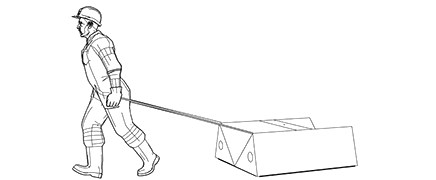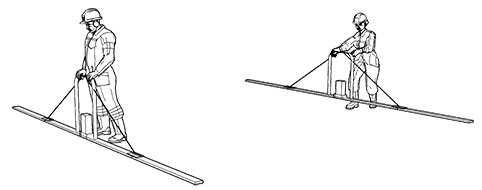ULTRA GPR

With over 20 years’ of experience with GPR in challenging environments, Groundradar recognised a need for a complete redesign of the typical georadar instrument. The design of low-frequency GPR systems has not changed since the 1980’s, with fragile antennas, fiber optics, bulky electronics and the need for laptop computers to record data common to all commercial systems. Data production is limited to flat terrain with wide cutline’s, with a typical production rate of a few kms a day.
Addressing each drawback of consumer-grade GPR system, UltraGPR is the most advanced deep radar system in the world. Whilst commercial GPR systems tips the scales more than 20 Kg, UltraGPR weighs less than 4 Kg, including the data logger. All fiber optic cables and wires have been replaced by wireless protocols, including Bluetooth and Wi-Fi. The in-line, or collinear, antenna orientation enables rapid surveying over the most rugged terrain. The ubiquitous laptop common to consumer-grade GPR systems has been replaced by a waterproof Android tablet. Indeed, the entire radar system may be submerged at depths of up to 20 m for underwater surveying.
As ground-breaking as these advancements in design are, the introduction of full waveform capture within UltraGPR’s receiver offers the greatest depth penetration of any available radar system. Rather than the sequential sampling method used by every major radar manufacturer, a technology developed in the 1960’s, UltraGPR captures the full reflected waveform in real-time. This enables stacking of 32,000 or 64,000 times during the same period a consumer-grade GPR would take to stack 32 times. In practical terms, increasing stacking this significantly can increase penetration two or more times.
AIR-RADAR

Air-Radar is the world’s first deep-penetrating GPR designed for drone use. The technology uses a real-time sampling receiver with a fast impulse transmitter and custom antennas to achieve penetration to 8 m in soil with a resistivity of 800 Ohm m and 20 m in 4,000 Ohm m soil. Processing of airborne GPR data is far more complex than for ground-based systems, and the technology is only suitable in specific environments. The system has been designed for a centre-frequency of 100 MHz but can be adapted for lower frequencies as needed. The entire system weighs 370 grams, complete with batteries and mounting hardware to DJI and similar drones. The system can on-board memory for recording both the GPS and the on-board RTK-DGPS data, as well as a high-powered WiFi connection for ground monitoring on an Android tablet or phone.
It is noted that GPR drone systems cannot be used at a height above 1 m according to ETSI (Europe), Industry Canada and FCC (USA) jurisdictions.
MINEVUE

Whilst UltraGPR offers the greatest penetration of any radar system available, in some environments, unshielded antennas radiate an undesirable portion of energy into the air. In these situations, typically characterized by water-saturated fine-grained soils (e.g. wet clays), or in regions where above-ground reflections will be substantial (urban settings, near power lines, etc), a powerful, low-frequency shielded antenna is required. The lowest frequency shielded GPR antenna currently available is 100 MHz, limiting penetration to approximately 10 m in most environments. MineVue was developed to address the need for deeper, and is the lowest-frequency shielded GPR system available. Centered at 40 MHz, MineVue is full shielded, yet collapsible into a flat bag for ease of travel. It is ideal for challenging radar environments with penetration up to 40 m in suitable conditions.
CONSUMER-GRADE GPR

The vast majority of Groundradar’s commercial projects involve deep and/or rapid radar profiling. However, Groundradar also operates a fleet of 19 consumer-grade GPR systems, manufactured by Sensors and Software, MalåGeoScience, and GSSI. These units are employed for shallow, high-resolution surveys where Groundradar’s long-range systems would not be suitable.
R&D PROJECTS
Groundradar is currently undertaking a series of in-house R&D projects involving deep penetrating GPR technologies. Research projects involve the development of magnetic loop antennas, as well as various forms of stepped-frequency GPR technologies. Groundradar expects to release a SFCW-GPR system by mid-2019 for rapid profiling of the 0 – 20 m depth range, in suitable conditions.
